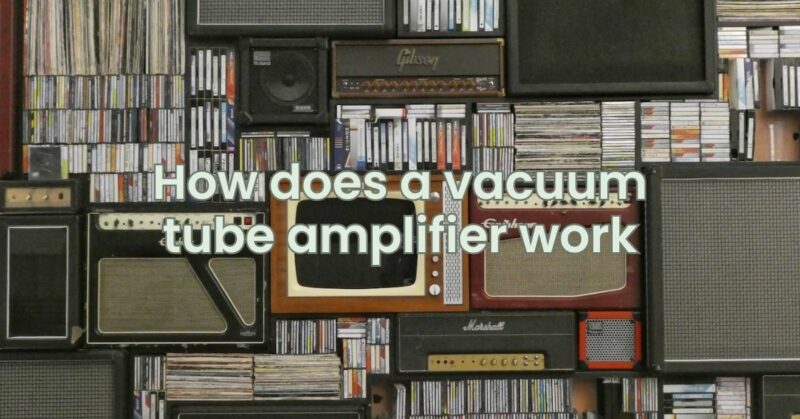In a world dominated by advanced solid-state technology, the charm and allure of vacuum tube amplifiers continue to captivate audiophiles and music enthusiasts worldwide. Often revered for their warm and rich sound, vacuum tube amplifiers, also known as valve amplifiers, represent a classic and nostalgic approach to audio amplification. In this article, we will delve into the inner workings of a vacuum tube amplifier, exploring the fundamental principles behind this timeless audio technology.
Understanding Vacuum Tubes
A vacuum tube is a type of electronic component that controls the flow of electrons within a vacuum. It consists of a glass or metal envelope enclosing electrodes and a vacuum, creating an environment where electrons can move freely from one electrode to another. The two main types of vacuum tubes used in audio amplification are triodes and pentodes, each with its unique characteristics and applications.
The Basic Components of a Vacuum Tube Amplifier
A vacuum tube amplifier is composed of several essential components, each playing a critical role in the amplification process. These components include:
- Vacuum Tubes: At the heart of the vacuum tube amplifier are the vacuum tubes themselves. Triodes, with three electrodes (cathode, anode, and control grid), and pentodes, with five electrodes (cathode, anode, control grid, screen grid, and suppressor grid), are the most common types used in audio amplification.
- Power Supply: The power supply provides the necessary voltages to operate the vacuum tubes. It converts the incoming alternating current (AC) from the wall outlet to the appropriate direct current (DC) voltages required by the amplifier circuit.
- Audio Input: The audio input is where the audio signal, typically coming from a source such as a CD player, turntable, or musical instrument, is fed into the amplifier.
- Preamp Stage: The preamp stage is the initial amplification stage where the weak audio signal is first amplified to a level sufficient for further processing.
- Tone Control: Some vacuum tube amplifiers include tone control circuits, allowing users to adjust the frequency response of the audio signal, often through bass and treble knobs.
- Power Amp Stage: The power amp stage is where the pre-amplified audio signal undergoes further amplification to a level suitable for driving speakers.
- Output Transformer: The output transformer is a crucial component in a vacuum tube amplifier. It matches the high impedance of the tubes to the low impedance of the speakers, efficiently transferring the amplified audio signal to the speakers.
- Audio Output: The amplified audio signal is finally directed to the speakers, producing the characteristic warm and rich sound associated with vacuum tube amplifiers.
How a Vacuum Tube Amplifier Works
The basic operation of a vacuum tube amplifier can be summarized in the following steps:
- Signal Input: The audio signal from a source, such as a music player or instrument, is connected to the input of the vacuum tube amplifier.
- Preamp Stage: In the preamp stage, the weak audio signal is amplified by the triode vacuum tubes. The control grid controls the flow of electrons between the cathode and anode, resulting in the amplification of the audio signal.
- Tone Control (Optional): If the amplifier includes tone control circuits, the user can adjust the bass and treble frequencies to tailor the sound to their preference.
- Power Amp Stage: After the preamp stage, the amplified audio signal enters the power amp stage, where the more powerful pentode vacuum tubes are commonly used. Here, the signal undergoes further amplification to a level suitable for driving speakers.
- Output Transformer: The amplified audio signal leaves the power amp stage and is transferred to the output transformer. The output transformer matches the high impedance of the tubes to the low impedance of the speakers, allowing efficient power transfer.
- Speaker Output: The enhanced audio signal finally reaches the speakers, producing the warm, harmonic, and dynamic sound characteristic of vacuum tube amplifiers.
Advantages of Vacuum Tube Amplifiers
The enduring appeal of vacuum tube amplifiers lies in their unique sound characteristics and nostalgic charm. Some of the advantages include:
- Warm and Harmonic Sound: Vacuum tube amplifiers are celebrated for their warm and harmonically rich sound, which many find more pleasing and musical than the cleaner but sometimes sterile sound produced by solid-state amplifiers.
- Natural Compression: Tube amps exhibit a more gradual and smooth compression when driven to their limits, creating a more forgiving and musical distortion that appeals to musicians and audiophiles alike.
- Dynamic Response: Vacuum tubes respond differently to changes in volume and audio signals, providing a more dynamic and expressive listening experience.
Conclusion
While modern solid-state technology has revolutionized audio amplification, vacuum tube amplifiers continue to occupy a special place in the hearts of audiophiles and music enthusiasts. By utilizing vacuum tubes to control electron flow, these classic amplifiers produce a distinctive warm, harmonic, and dynamic sound that transports listeners back to a golden era of audio.
Whether you are a seasoned audiophile seeking an emotional connection to your music or simply exploring the enchanting world of audio amplification, a vacuum tube amplifier offers a captivating and nostalgic way to experience the magic of classic audio reproduction.


